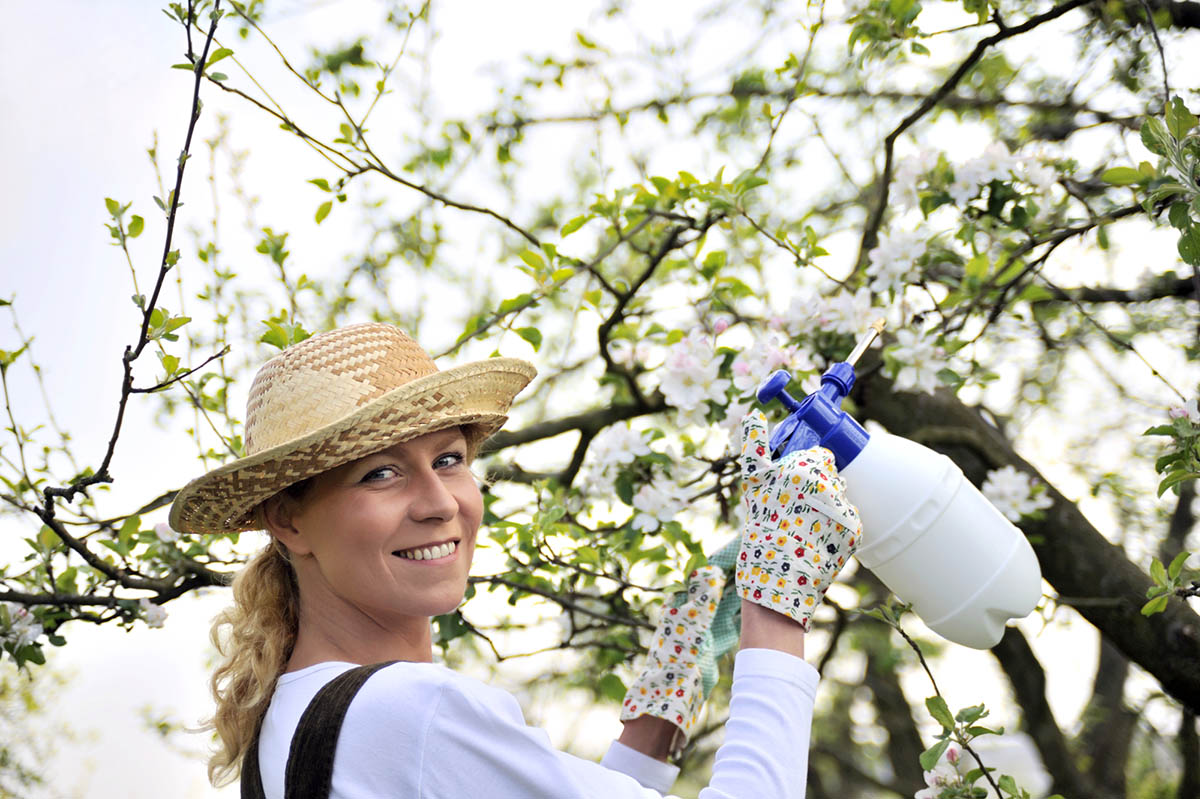

We may earn revenue from the products available on this page and participate in affiliate programs. Learn More ›
Q: The fruit on several fruit trees in my garden grows poorly and the leaves look bad. I probably need to spray the trees, but don’t know how or when to go about it. Can you tell me when to spray fruit trees?
A: Caring for fruit trees is a year-round job that includes pruning, fertilizing, removing diseased fruit, and spraying at different times of the year. Timing is critical for each of these tasks. During active growth, the trees absorb and use nutrients from fertilizers.
To know when to spray fruit trees for pests, you first need to know what threatens the tree and when the threat is active. An insect egg can lie dormant in the bark of an apple tree all winter, only to hatch and feed on the leaves in spring. Or a particular fungal spore might infect a peach tree only while the flowers are open.
Develop a fruit tree spraying schedule based on the growing cycle and threat.
Good timing is key to controlling diseases and insects. Though it requires careful observation, timing tree spraying applications to coincide with plant and fruit development, along with climate and weather, will yield optimal results. Watch for specific growth stages with observable characteristics:
• Dormancy is before buds begin to swell in spring.
• Pre-blossom stage includes five distinct growth stages for tree buds before the flowers open:
- silver buds
- green tips
- half-inch green
- tight clusters (of flower buds)
- pink (but not yet open) flower buds.
• Blossom is from the time the first flower opens until the last petal drops.
• Petal fall is the time after blossom, before the first tiny fruits begin to develop.
• Fruit formation is the final stage, which lasts until harvest.
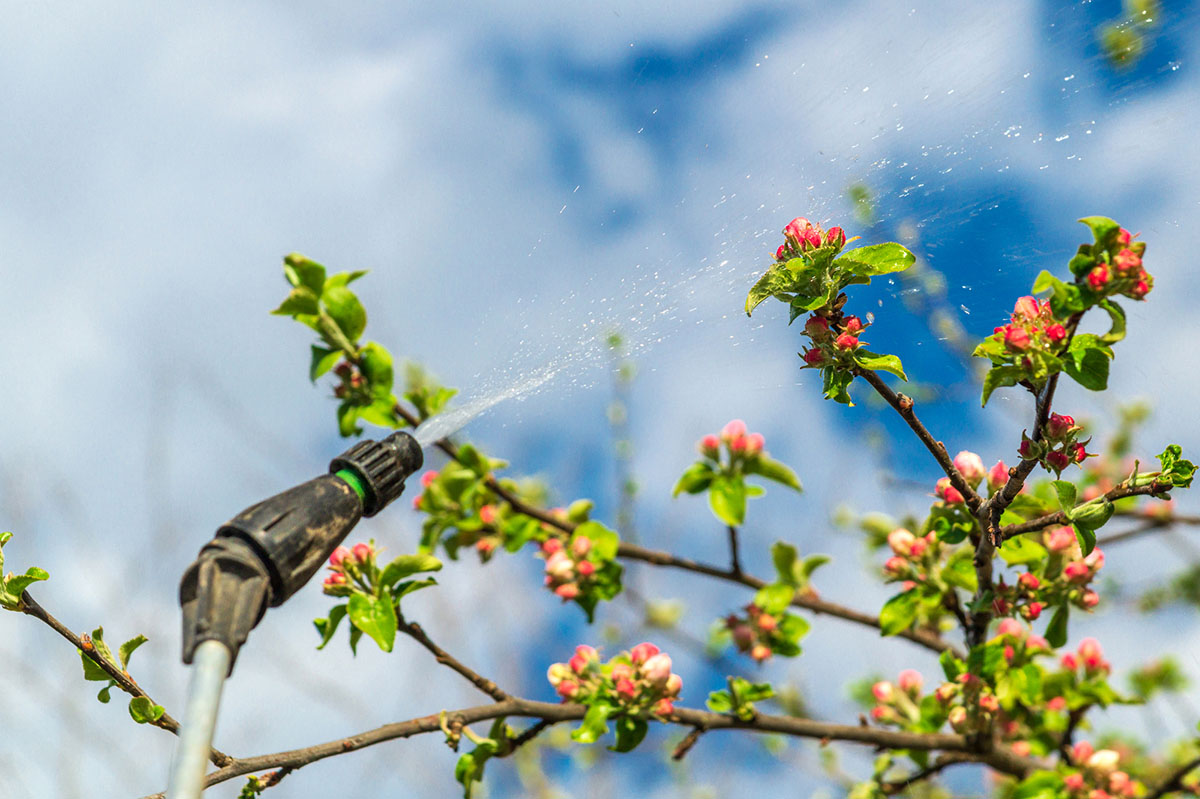
Avoid spraying fruit trees while flowers are open, since insecticides sprayed at that time kill bees and other pollinators. Read and follow all safety precautions to minimize personal exposure to pesticides. Always follow mixing instructions. Increasing the concentration of a spray does not kill insects faster, can kill more beneficial species, and increases chances of runoff contaminating local streams and groundwater.
-
Dormant spray, or dormant oil, is a horticultural oil that kills overwintering scale insects, mealybugs, mites, aphids, and other pests on the bark. The oil has either a mineral (petroleum) or plant base. One application of dormant spray for fruit trees per year, or less, is typical. Plantonix Organic Neem Bliss is an effective and organic fruit tree spray for overwintering pests, as is Bonide All Seasons Horitcultural and Dormant Spray Oil.
-
Insecticidal sprays kill insects that feed on foliage, bore into trunks, or spoil developing fruit. Most fruits require multiple applications through the growing season for active bugs. Avoid spraying insecticides while flowers are present. BioAdvanced Vegetable and Garden Insect Spray protects fruit and lasts longer than some sprays.
-
Fungicidal sprays control the spread of fungal diseases. You might need to apply fungicide several times throughout the growing season to protect against different diseases. Many of these products can damage or kill pollinators, so avoid spraying fungicide while flowers are open. Grower’s Ally Fungicide Concentrate can protect fruits and vegetables.
-
General-purpose sprays control most insects and diseases affecting fruit trees; spraying a single product at defined intervals throughout the growing season is easier than timing a specific fruit spray. However, using only a general-purpose fruit tree spray increases unnecessary pesticide exposure and might not control some insects and diseases. Try Bonide’s Captain Jack’s Friut Tree Spray, a concentrate meant for citrus, nut, and fruit trees.
-
Foliar fertilizer sprays of micronutrients like zinc, copper, magnesium, molybdenum, boron, and calcium can aid fruit development where these nutrients are lacking or unavailable due to soil alkalinity. These elements mix with water and spray directly on leaves, which absorb the nutrients and move them to developing fruits. Strictly follow label instructions to avoid damaging trees. Consider Bloom City’s Organic SuperGreen, which includes beneficial magnesium and kelp.

If there was intense pest activity during the previous growing season, use dormant spray for fruit trees in late winter or early spring.
Dormant sprays kill overwintering insect pests on fruit trees. Unless pest populations spike, it is not necessary to spray dormant oil every year. Every 3 to 5 years is typical.
Complete dormant spraying before buds begin to swell. Apply dormant spray only when the temperature is above 40 degrees Fahrenheit. Be sure to fully coat all surfaces, paying close attention to undersides of branches and branch crotches.
RELATED: How to Plant a Tree
Apply insecticidal sprays as needed at 2-week intervals from green tip until bloom, and from petal drop until harvest.
It is possible for insects to build up tolerance to even the best insecticide if it is used repeatedly. The solution is to alternate applying insecticides with other active ingredients.
If you primarily use a general-purpose spray to kill insects and diseases, alternate treatments using a specific-purpose insecticide to eliminate the risk of pests building up tolerance to either chemical. An insecticidal soap, such as Natria Insecticidal Soap, can be used right up to the day of harvest.
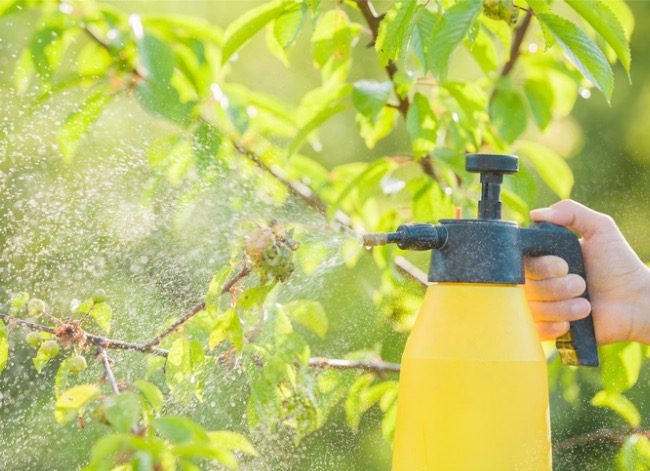
Each kind of fruit tree has its own ideal fungicide spray schedule based on the diseases that threaten it.
Targeted, stand-alone fungicide treatments improve fruit quality when applied at the proper time. Fruit disease spores infect their hosts when environmental conditions are ideal.
Some fungal spores activate during cool, wet spring weather. Other diseases spread in hot, humid summer conditions. It is important to anticipate plant diseases and begin treating them just before they arrive.
Fungicide applications are most critical during the green tip through petal fall stages of pear and apple trees. Peach trees and plum trees require spring, summer, and fall disease control treatments for best results.
Find application timing on the product label to prevent specific diseases, or check the Purdue University Extension Guide for growth stage and fruit tree spray schedules specific to common fruits.
RELATED: 10 Indoor Fruit Trees You Can Grow at Home Year-Round
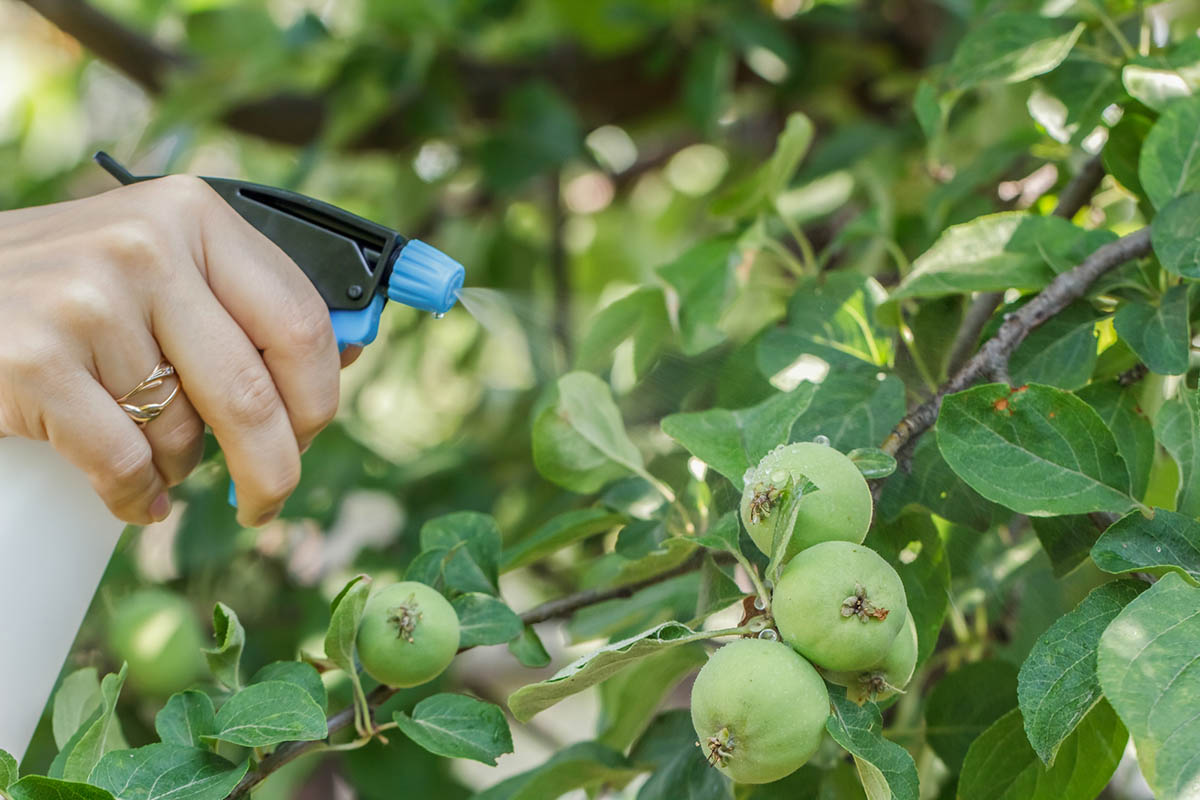
Use general purpose fruit tree spray at 1- to 2-week intervals as trees develop.
Apply the spray first at green tip, followed by pre-bloom, full pink, petal fall, first cover (1 week after petal fall), and second cover (2 weeks after petal fall).
General-purpose fruit tree sprays cut spray application time in half. A powerful mix of broad-spectrum insecticide and fungicide is the key. Active ingredients might include organic products like pyrethrins and neem oil, or inorganic chemicals like malathion, carbaryl, and captan.
Some trees might require additional treatments. Consult the product label for detailed directions.
Apply foliar sprays of micronutrients on a cool, overcast day at or near the petal drop stage.
If your fruit trees are deficient in zinc, copper, magnesium, molybdenum, boron, or calcium, a foliar application of one or more of these micronutrients may help. Be cautious; unnecessary or excessive application of these nutrients can damage fruit trees.
Foliar fertilizer cannot replace proper soil fertility. A tree cannot absorb enough of the major nutrients it needs through foliage.
RELATED: 7 Common Tree Diseases and How to Treat Them Before it’s Too Late
Apply granular fertilizers in early spring.
The best time to fertilize fruit trees is in early spring. Apply a granular fertilizer such as Jobe’s Organics All Purpose Granular Plant Food across the root zone around the time the leaf buds open. The first flush of growth in spring comes from energy stored in the roots. By the time the fertilizer penetrates the soil, the tree is ready to take up the nutrients for optimum growth and fruiting.
Avoid fertilizing after mid-spring. A spike in soil nutrients during fruit development can cause trees to abort fruit to produce more vegetative growth.
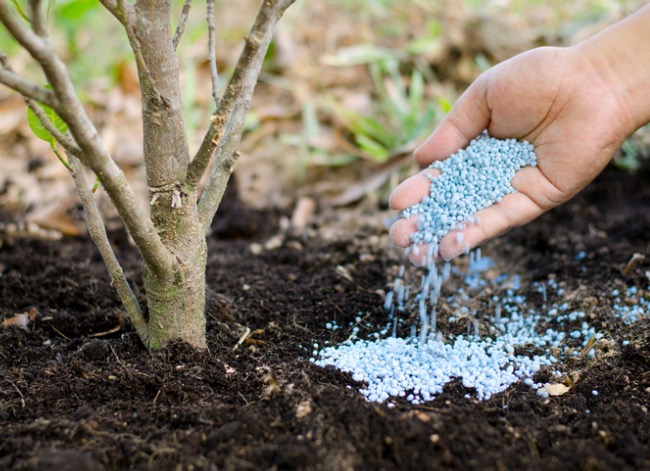
Use combination sprays during the growing season to target both insects and diseases.
Combination sprays are two different pesticides sold individually, normally an insecticide and a fungicide, mixed into the same pump sprayer and applied at the same time. This practice is a way to customize an application and save time.
Not all products are compatible, and some mixtures can be dangerous. Read both product labels before mixing to ensure that mixing the two is safe and allowable.
